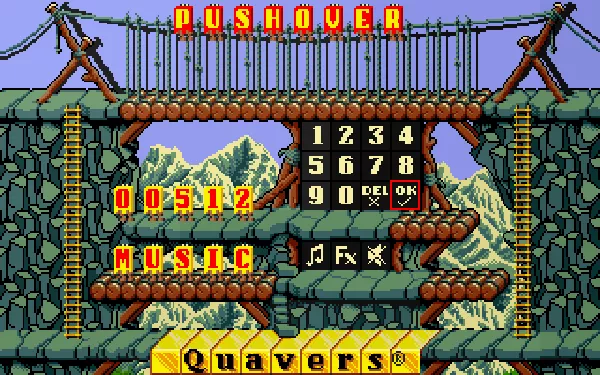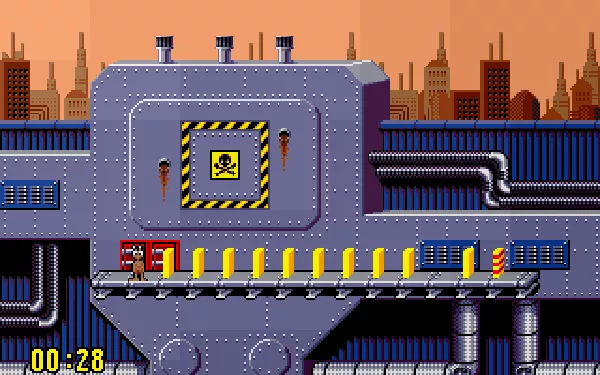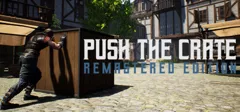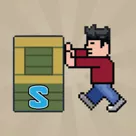Push-Over
Description
You're playing a small ant that is willing to help a friend in a rather inconvenient situation. Apparently, the Quavers mascot Colin Curly likes his Quavers so much he lost balance and dropped them down a giant ant-hill. It's now your job to go in, in a mission to solve puzzles and retrieve the snacks for your friend.
Now, this ant-hill is a bit different from the ones you saw, and especially from the one you live in. Its path is filled with domino-like tiles and closed gates that must get through to find the snacks. You'll have to traverse different themed worlds in order to retrieve Colin's precious Quavers.
The main game consists in controlling the ant from a standard third-person platformer perspective and moving dominoes to place them in a well imagined line, so that when you push the correct one, all of them fall with a specifically marked tile falling last. The door will otherwise stay shut and you will be unable to progress. In addition to that, your ant can't fall from too high or it will die and make you restart the level.
Every domino tile has its own marking. For example, yellow ones are the ones you simply push in a direction so they push the one next to them, most often in a chain reaction. Red ones, on the contrary, can't be pushed at all (but can be moved) and tiles that hit it will fall back in the opposite direction. Other types of tiles include one that explodes when being pushed or hit by another tile, clearing the way for other tiles; one that keeps moving ahead until it hits another tile; one that creates a bridge over a gap; or one that moves straight up and stick to the ceiling, pushing a tile next to it.
Each level is timed and requires quick thinking in order to be completed successfully. Upon completion of a level, the player is given a password that can be used to resume the game at the level they last left off.
The SNES version doesn't have the Quavers branding and involves retrieving drops of cash for a rat character instead.
Groups +
Screenshots
Promos
Credits (DOS version)
16 People (12 developers, 4 thanks)
| PC Programming | |
| Graphics | |
| Music | |
| SFX | |
| Puzzles | |
| Thanks to |
Reviews
Critics
Average score: 82% (based on 25 ratings)
Players
Average score: 3.9 out of 5 (based on 28 ratings with 2 reviews)
A timeless puzzle game that is always a good exercise on your brain
The Good
It's a puzzle game that's easy to jump into. It's not ridiculously hard, and its design is intuitive, so you find yourself feeling smart when you succeed in a level. The game is also quirkily funny. It's fun to play when you feel like stimulating your brain - It's a pure video game experience that allows you to think beyond jump, shoot, kill, get.
The Bad
What's not to like? If you're not into playing puzzle games, you won't like this game. It is everything it promises. All 100 levels of it. Perhaps the graphics are a bit dated looking, but that's really because the game came out 18 years ago. Hard to believe...
The Bottom Line
It's a puzzle game where the object is to arrange the dominoes that are scattered throughout each level in such a way that one push results in all of them falling down with the finishing domino falling last. You play through 100 levels of gradually increasing difficulty, but it at no point becomes maddeningly hard. It's really a well-designed game that transcends its own time of release, like tetris. It doesn't rely on its graphics, sound, or presentation to make it worthwhile - it's like how you can play a game of chess with sticks in the sand if you wanted to.
DOS · by Feem (30) · 2005
The Good
The game is clever. The concept of setting dominos to fall down in a sequence is simple and fun, and this games takes it to another level. The different kind of domino pieces (bridger, exploder, splitter, tumbler) makes for an infinite amount of puzzles, from utterly simple to quite challenging. The ant must single-handedly move the pieces, so you also have to account for it's moving limitations, meaning some pieces cannot be moved, and you must calculate the exit route.
Also, the game makes use of cartoon-like humor from the main character, the little ant. Take too long to move and it'll yawn. Walk next to the "exploder" domino and it will cover it's ears. Walk over the ledge with a piece in hands and you'll suddenly realize you've "ran out floor"...
The Bad
The infinite amount of puzzles isn't always a plus. The game tends to get a bit repetitive and sometimes boring, and it's very, very long. Changing backgrounds isn't enough to ease this problem.
Also, it's not that well balanced, since you stumble upon some hard puzzles early on, and some ridiculously easy later.
The Bottom Line
If you're a Lemmings fan, or any puzzle game fan for that matter, be sure to give this one a try, since it's original all in it's own.
DOS · by tbuteler (3021) · 2003
Trivia
Sponsor
Pushover, along with its sequel, One Step Beyond, were both sponsored by Quavers, a popular British snack food. Quavers' former mascot, Colin Curly, is featured in both games (in the intro for Pushover, and as the main character in One Step Beyond).
Version differences
The SNES version completely lacks any reference to Quavers or Colin Curly - replacing them instead with bags of money, and a new character named Captain Rat, respectively.
Awards
- Amiga Joker
- Issue 02/1993 – #3 Best Strategical of 1992 (Readers' Vote)
- PC Games (Germany)
- Issue 01/1993– #3 Best Strategy Game in 1992
- ST Format
- January 1993 (issue #42) - #15 in '50 finest Atari ST games of all time' list
Analytics
Identifiers +
Contribute
Are you familiar with this game? Help document and preserve this entry in video game history! If your contribution is approved, you will earn points and be credited as a contributor.
Contributors to this Entry
Game added by MAT.
Macintosh, Linux added by Rik Hideto. SNES added by Simon Wingate. Windows added by Foxhack. Atari ST, Amiga added by Martin Smith. Antstream added by lights out party.
Additional contributors: wildweasel, Patrick Bregger, Jo ST.
Game added June 26th, 2000. Last modified January 21st, 2024.




















